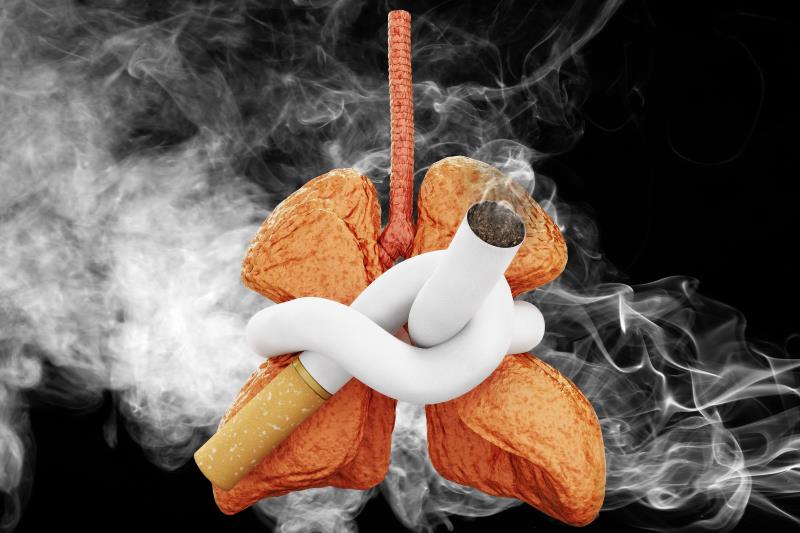
The lung damage acquired from smoking persists years after smoking cessation, with a faster decline in lung function in former smokers compared with never-smokers, according to a recent US-based study.
“Accelerated decline in lung function persisted for decades after smoking cessation; was present in smokers with fewer than 10 pack-years; and was evident in current smokers reporting less than five cigarettes per day … [and] persisted in adults without prevalent lung disease,” said the researchers.
“Our results therefore reinforce the view that there is no safe level of tobacco smoke exposure and … highlight the importance of smoking prevention and cessation, including with respect to so-called social smoking.”
Data on lung function was obtained from six US population-based cohorts with different age groups (two each comprising patients aged ≥17, ≥45, and ≥65 years) in the NHLBI* Pooled Cohort Study. The final study population comprised 25,352 community-dwelling individuals aged 17–93 years at baseline who completed a total of 70,228 spirometry examinations.
Over a median 7-year follow-up period, at a median age of 57 years, all individuals exhibited a decline in FEV1, including sustained never-smokers (31.01 mL/year), former smokers (34.97 mL/year), and current smokers (39.92 mL/year).
After adjustment, former smokers experienced an accelerated FEV1 decline of an estimated** 1.82 mL/year compared with never-smokers (p<0.0001), with the decline persisting decades following smoking cessation. [Lancet Respir Med 2019;doi:10.1016/S2213-2600(19)30276-0]
This was approximately 20 percent of the magnitude of the FEV1 decline in current smokers with low cumulative cigarette consumption (<10 pack-years) which was estimated at 9.21 mL/year compared with never-smokers (p<0.0001).
Former smokers with a shorter duration of smoking cessation had a more accelerated FEV1 decline than those with a longer duration of cessation (adjusted difference, 2.50 and 0.93 mL/year for 20 to <30 years and ≥30 years cessation, respectively, compared with never-smokers; p<0.0001 and p=0.0104, respectively).
“It is reassuring to see that former smokers will, following smoking cessation, eventually approach the normal age-related FEV1 decline of never-smokers,” said Dr Yunus Çolak and Professor Peter Lange from the Herlev and Gentofte Hospital, Copenhagen University Hospital, Herlev, Denmark, in a commentary. [Lancet Respir Med 2019;doi:10.1016/S2213-2600(19)30349-2]
Among low-intensity current smokers (<5 cigarettes/day), estimated FEV1 decline was 68 percent that of high-intensity current smokers (≥30 cigarettes/day; adjusted difference, 7.65 and 11.24 mL/year, respectively) and almost fivefold that of former smokers (1.57 mL/year; p<0.0001 for all vs never-smokers).
FEV1 decline was greater in individuals with prevalent lung disease, at rates of 3.40 and 1.10 mL/year in former smokers with and without prevalent lung disease, respectively, vs never-smokers. Among those without prevalent lung disease, former smokers who had ceased smoking for ≥30 years had an FEV1 decline similar to that of never-smokers (0.53 mL/year; p=0.1457), though this did not apply to low-intensity current smokers whose FEV1 decline remained high compared with never-smokers (4.72 mL/year; p<0.0001).
While previous research has demonstrated a deceleration in FEV1 decline following smoking cessation, [BMC Med 2010;8:84] the reversion of lung function to that of never-smokers has not been established, the researchers noted.
“[P]ersistent increase [in lung damage after smoking cessation, as evident in this study] implies ongoing deterioration that might warrant additional preventive strategies,” they said. Additionally, the evidence suggesting lung function decline in even low-intensity current smokers “raise[s] concerns about novel tobacco products marketed as low-dose products.”
“[W]e should not promote low-intensity smoking and use of low-dose tobacco products as a means of harm reduction but instead promote early smoking cessation,” added Çolak and Lange.
The researchers acknowledged several limitations including self-report of smoking status that may have led to bias, as well as lack of information on inhalation technique which could have affected lung function decline.